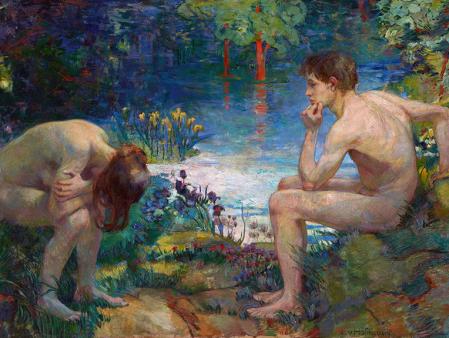We is Future: Museum Folkwang dedicates an extensive themed exhibition to artistic visions of living together
From 24 November 2023 to 17 March 2024, Museum Folkwang presents the exhibition We is Future. Visions of new Communities. The show presents around 160 works from 120 years of artistic reflection on an ideal way of living together. Starting with the Lebensreform movement around 1900, the exhibition leads through Bruno Taut's Alpine Architecture, Constant's New Babylon and Anna Halprin's Planetary Dance to works of contemporary art.
Our attitude to life today is characterised by the threat to our habitats. Demands for fundamental changes are therefore becoming increasingly urgent. But how can the seemingly unchangeable be rethought? What new forms of living together are desirable at all? Based on these contemporary issues, the exhibition We Is Future. Visions of New Communities examines historical and current ideas for alternative forms of living together. Using a variety of media such as painting, sculpture, graphics, video and performance, the presentation culminates in a temple-like installation created especially for the exhibition by architect and artist Yussef Agbo-Ola [Olaniyi Studio].
We is Future begins at the end of the 19th century, when the negative consequences of industrialisation and urbanisation were already becoming apparent. Counter-movements and alternatives were not long in coming. The longing for earthly paradises is outlined in the first chapter of the exhibition with a monumental wall frieze (1888-1892) by Karl Wilhelm Diefenbach, which depicts a joyful union of humans and animals and various religions. Gusto Gräser and Ludwig von Hofmann are also driven by the hope of a free life in harmony with nature. Paintings such as Hofmann's Paradise Lost (Adam and Eve) (1893) symbolise the lost unity between man and nature and at the same time raise the question of how the desired ideal state can be rediscovered. Elisàr von Kupffer immediately sketches a new religion. In his homoerotic paintings, he shows what it might look like in the so-called Klarwelt der Seligen.
Bruno Taut and Wenzel Hablik used the new materials of steel and glass to design architecture whose forms were inspired by crystal. After the horrors of the First World War, their crystalline architectural designs symbolised the new age and called for a new way of building for a new society. Buildings that could be seen from afar were to strengthen the sense of community and bring about a peaceful, more liveable society. In the Alpine Architecture portfolio (1917/18), Taut also proposed a joint development of the Alps by the people of the neighbouring countries in order to achieve lasting peace in Europe. He found a long-term supporter in the founder of Museum Folkwang, Karl Ernst Osthaus. Osthaus published Taut's drawings in 1920 in the Folkwang publishing house and engaged him for the architecture of his favourite project, a reform school with which they wanted nothing less than to improve coexistence and society.
A separate chapter is dedicated to Constant's work complex New Babylon. From 1956 to 1974, the Dutch artist designed a new modular and flexible living environment in numerous paintings, drawings and models. Here, man at play (homo ludens) builds his own environment for a new society. Everyone creates the desired climatic and social situation and moves through the labyrinthine sectors as part of a "collective creativity". Little by little, New Babylon would spread across the globe and bring people from all continents together.
We is Future also tells of the hippie modernism of the 1960s and 1970s and its consequences. At the beginning of the 1970s, the Italian design and architecture group Superstudio envisioned an earth-spanning megastructure on which people would live nomadically, without objects, without work, without hierarchies, without consumption, but full of communication, information and free development. From 1980 onwards, Anna Halprin's Planetary Dance, which has been performed again and again to this day, is about reconnecting with nature and renewing the community through a physical and spiritual group experience in the present. The artists' visions are brought into the exhibition space in sketches, collages and films.
The final chapter of the exhibition shows contemporary works by Eglė Budvytytė, Emma Talbot and Timur Si-Qin. Their current works address a new connection with nature and all living beings and confront historical positions with contemporary issues. Eglė Budvytytė's film Songs from the Compost: Mutating Bodies, Imploding Stars (2020) follows a group living in the forest that has already entered into new forms of symbiosis with nature, is colonised by lichens and fungi and has developed a crab-like locomotion. Timur Si-Qin, on the other hand, has been focussing on a balance and collaboration between nature and man since 2016 in his work complex New Peace, which is intended to enable a new, mysterious spirituality. In terms of both space and content, the exhibition threads come together in Oriji: 12 Stone Frog Temple by Yussef Agbo-Ola, a new production for Museum Folkwang. Inspired by the endangered poison dart frog, the expansive temple raises awareness of even the smallest creatures in the ecosystems that keep the world in balance and invites visitors to enjoy a sensory experience. The word Oriji means "forgiveness" in Agbo-Ola's native Yoruba language and is an expression of his personal compassion for the species and his remorse towards the global context. The pursuit of an ideal community that does not (yet) exist or no longer exists is the unifying element and the driving force behind the exhibited works.
The exhibition is made possible by the RAG-Stiftung as main supporter and E.ON as main sponsor. It is supported by the Ministry of Culture and Science of the State of North Rhine-Westphalia, the Alfried Krupp von Bohlen und Halbach Foundation and the Folkwang-Museumsverein e. V.
Ludwig von Hofmann
Paradise Lost (Adam and Eve)
Das verlorene Paradies (Adam und Eva), 1893
Oil on canvas, 130 × 195 cm
Hessisches Landesmuseum Darmstadt
Photo: Linda Breidert
Share on

